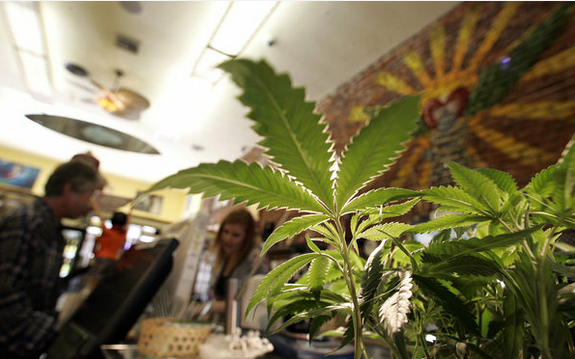Medical marijuana dispensaries would seem to be natural targets for criminals. According to a leading theory of criminology, pot dispensaries have several key attributes that put them at risk:
— They sell a product (marijuana) that is attractive to criminals.
— They usually operate on a cash-only basis (a cash stash also tends to attract would-be thieves).
— The clients of marijuana clinics carry cash (in order to purchase their medicine).
— Many clients are frail due to their medical conditions and may not be able to fight off attackers.
In Europe, “hash clubs” and other drug dispensaries have developed a reputation as being “a breeding ground for criminal networks,” according to a new study by two UCLAresearchers. And some recent headlines indicate that U.S. pot dispensaries may be on track to follow suit. A 2009 white paper from the California Police Chiefs Assn. made a pretty good case that they would:
“Marijuana dispensaries are commonly large money-making enterprises that will sell marijuana to most anyone. … While the dispensaries will claim to receive only donations, no marijuana will change hands without an exchange of money. These operations have been tied to organized criminal gangs, foster large grow operations, and are often multi-million-dollar profit centers. Because they are repositories of valuable marijuana crops and large amounts of cash, several operators of dispensaries have been attacked and murdered by armed robbers both at their storefronts and homes, and such places have been regularly burglarized.”
The pair of researchers from UCLA’s Luskin School of Public Affairs decided to see whether clinics in California (one of 17 states that has legalized medical marijuana, along with the District of Columbia) fit the European profile.
Nancy Kepple and Bridget Freisthler focused on Sacramento, where dispensaries operated for six years before local regulatory policies were put in place in 2010. The researchers mapped all 40 clinics in the city, figuring out whether they were in neighborhoods with many single-parent households, families living in poverty, vacant housing units, a high proportion of young men, easy access to a freeway on-ramp and other characteristics associated with crime.
Then they plugged in crime data from 2009 to see if there were any relationships between robberies, thefts and other acts of vice and the presence of drug dispensaries.
The models the researchers came up with confirmed that factors such as unemployment, commercial zoning and a high proportion of young adults were indeed associated with higher crime rates. But the number of marijuana clinics in a neighborhood had nothing to do with any of it, they found.
Writing up their results in the July issue of the Journal of Studies on Alcohol and Drugs, however, the researchers didn’t seem to be persuaded by their own results. They noted that one possibility is that “the density of medical marijuana dispensaries may not be associated with neighborhood-level crime rates,” but they also theorized that the relationship “is likely more complex” than could be measured with the available data.
To make a convincing case that pot dispensaries really don’t contribute to crime, the outlets would need to be tracked in more cities for a longer period of time, they wrote.
You can read the study online here.

